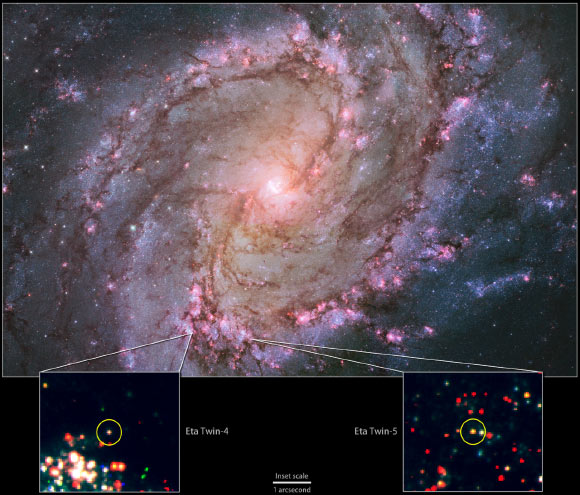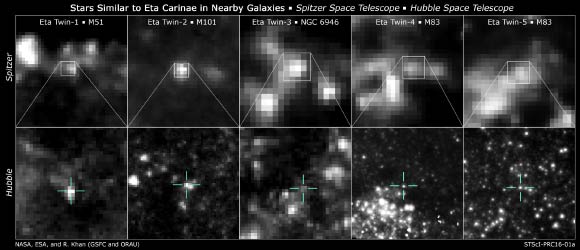Using the NASA/ESA Hubble and NASA’s Spitzer space telescopes, astronomers have discovered five very luminous and massive stellar systems in the star-forming galaxies NGC 6946, Messier 51, Messier 83, and Messier 101.

Messier 83 is currently the only one known to host two Eta Carinae-like stars. This composite image shows a galaxy ablaze with newly formed stars; a high rate of star formation increases the chances of finding massive stars that have recently undergone an Eta Carinae-like outburst. Bottom: insets zoom into Hubble data to show the locations of Messier 83’s Eta Carinae twins. Image credit: NASA / ESA / Hubble Heritage Team / STScI / AURA / R. Khan, GSFC & ORAU.
“The most massive stars are always rare, but they have tremendous impact on the chemical and physical evolution of their host galaxy. These stars produce and distribute large amounts of the chemical elements vital to life and eventually explode as supernovae,” said Dr Rubab Khan of NASA’s Goddard Space Flight Center, lead author of a study published in the Astrophysical Journal Letters (arXiv.org preprint).
The newly discovered giant stars are twins of Eta Carinae, a massive binary stellar system located within our Milky Way Galaxy, roughly 7,500 light-years away.
According to astronomers, Eta Carinae outshines our Sun by 5 million times and consists of two massive stars in a 5.5-year orbit. The more massive star has 90 times the Sun’s mass, while the smaller companion may exceed 30 solar masses.
As one of the cosmic labs for studying extremely massive stars, Eta Carinae has been a unique object since its eruption in the 1840s. To understand why the eruption occurred and how it relates to the evolution of such stars, scientists needed additional examples.
“We knew others were out there. It was really a matter of figuring out what to look for and of being persistent,” said Ohio State University astronomer Prof. Krzysztof Stanek, a co-author on the study.

Eta Carinae twins: top – images of Eta Carinae-like stars from NASA’s Spitzer; bottom – images of the same sources from the NASA/ESA Hubble Space Telescope. Image credit: NASA / ESA / R. Khan, GSFC & ORAU.
Dr Khan, Prof. Stanek and their colleagues developed a kind of optical and infrared fingerprint for identifying possible Eta Carinae twins.
“With NASA’s Spitzer Space Telescope we see a steady increase in brightness starting at around 3 microns and peaking between 8 and 24 microns. By comparing this emission to the dimming we see in Hubble’s optical images, we could determine how much dust was present and compare it to the amount we see around Eta Carinae,” Dr Khan said.
In a survey of several galaxies, the astronomers found two Eta Carinae-like stars in Messier 83, and one each in NGC 6946, Messier 51 and Messier 101.
These five giant objects mimic the optical and infrared properties of Eta Carinae, indicating that each very likely contains a high mass star buried in five to 10 solar masses of gas and dust. Further study will let astronomers more precisely determine their physical properties.
_____
Rubab Khan et al. 2015. Discovery of Five Candidate Analogs for ηCarinae in Nearby Galaxies. ApJL 815, 2, L18; doi: 10.1088/2041-8205/815/2/L18







